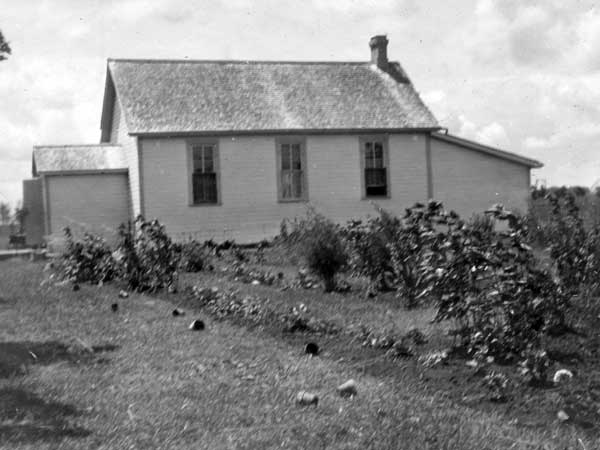Benjamin Casselman, his wife seven daughters and one son were the first settlers in what would become Oak Bluff. The family arrived from Ontario in 1870 and got supplies from the St. Charles settlement on the north bank of the Assiniboine River. The girls attended school at the convent there.
Qualico Communities named Casselman Crescent in their honour.

Source:
Archives of Manitoba, School Inspector Photos GR2664, C65
Shortly after Manitoba became a province in 1870, the federal government started encouraging more settlement of the Canadian west. The Homestead Act of 1872 allowed pioneers to own 160 acres if they cultivated and resided on the land for at least six months in each of the first three years. At around the same time, the Dominion Land Survey was conducted in the area south and west of Winnipeg, dividing the prairie into sections, townships and ranges. Oak Bluff began to attract new residents as a result.
About 1880, British real estate agents started selling Canadian land to prospective pioneers for two to three dollars an acre. The area was largely settled by English, Scottish and a few Irish pioneers. In 1881, the Municipality of Macdonald was formed, and the village of Oak Bluff sprang up.
William West and his family of five arrived from England in 1883 and built their home on a ridge with natural drainage and a grove of oaks. William Mellow, the local mail carrier, left mail at the West house for settlers in the area. In 1889, the West home was named the first official Post Office for the community and Mr. West was more Postmaster.
Because of the home's location on a ridge surrounded by oaks, the Post Office was called Oak Bluff.
By 1889, about one dozen families had settled in the Oak Bluff area. The first school was built on a site donated by Benjamin Casselman; it was named Otto School District No. 600, in memory of the Casselmans' son, who had been killed in a farm accident. In 1913, all schools in the municipality were combined and the Oak Bluff Consolidated School was built. Students living five to 10 miles from the school were transported in vans pulled by horses.
Initially, church services were held periodically in private homes, with two or three families in attendance whenever a minister traveled the 'circuit' to serve scattered congregations. After the schools were built, they served the dual purpose of housing regular church services. Presbyterians were the first to form a congregation and gold regular services. The United Church soon followed as did congregations of Roman Catholics, Greek Orthodox and Mennonites.
Railway service arrived in the community in 1901 and a grain elevator was built. By the time Americans and Europeans arrived in the growing agricultural community, shortly after 1910, land prices had risen to $25 an acre. Oak Bluff slowly evolved from an agricultural community to a small village. By 1922, the community had two schools, a post office and a store. Over the ensuring years, more homes and a service station were added to the community. In 1960, the Metropolitan Winnipeg Act was passed, which gave the City control over land five miles beyond the Perimeter Highway. The City then changed the zoning of the area around Oak Bluff village to residential, commercial or agricultural. Over time, new homes were built along several of the road frontages and in 1975, a 25-acre housing development went in west of Highway 3 and across from the school, with two acres reserved for a recreation park.
As a result, the population increased to 165 by 1984. Three large businesses were added in the commercial zone: a garage and car dealership, a farm equipment operation, a large service station and restaurant. A recreation complex was planned and built by Oak Bluff residents.
Today, Oak Bluff is attracting new residents from both the surrounding rural area and from Winnipeg. They are drawn by the quiet friendliness of the community, its lower tax base and its excellent proximity to Winnipeg.
References: Oak Leaves, A History of the Oak Bluff District, the Oak Bluff Women's Institute, 1984 and Hugging the Meridian, Macdonald: A Manitoba Municiapal History 1881-1981, Betty Dyck, 1981